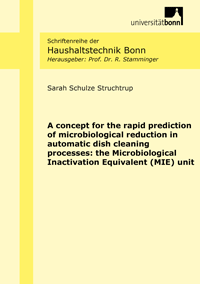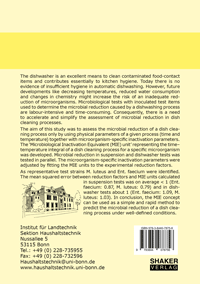
Shop : Details
Shop
Details
45,80 €ISBN 978-3-8440-7875-6Softcover128 pages25 figures189 g21 x 14,8 cmEnglishThesis
March 2021
Sarah Schulze Struchtrup
A concept for the rapid prediction of microbiological reduction in automatic dish cleaning processes: the Microbiological Inactivation Equivalent (MIE) unit
The dishwasher is an excellent means to clean contaminated food-contact items and contributes essentially to kitchen hygiene. Today there is no evidence of insufficient hygiene in automatic dishwashing. However, future developments like decreasing temperatures, reduced water consumption and changes in chemistry might increase the risk of an inadequate reduction of microorganisms. Microbiological tests with inoculated test items used to determine the microbial reduction caused by a dishwashing process are labour-intensive and time-consuming. Consequently, there is a need to accelerate and simplify the assessment of microbial reduction in dish cleaning processes.
The aim of this study was to assess the microbial reduction of a dish cleaning process only by using physical parameters of a given process (time and temperature) together with microorganism-specific inactivation parameters. The ‘Microbiological Inactivation Equivalent (MIE) unit’ representing the time–temperature integral of a dish cleaning process for a specific microorganism was developed. Microbial reduction in suspension and dishwasher tests was tested in parallel. The microorganism-specific inactivation parameters were adjusted by fitting the MIE units to the experimental reduction factors.
As representative test strains M. luteus and Ent. faecium were identified. The mean squared error between reduction factors and MIE units calculated in suspension tests was on average < 1 (Ent. faecium: 0.87, M. luteus: 0.79) and in dishwasher tests about 1 (Ent. faecium: 1.09, M. luteus: 1.03). In conclusion, the MIE concept can be used as a simple and rapid method to predict the microbial reduction of a dish cleaning process under well-defined conditions.
The aim of this study was to assess the microbial reduction of a dish cleaning process only by using physical parameters of a given process (time and temperature) together with microorganism-specific inactivation parameters. The ‘Microbiological Inactivation Equivalent (MIE) unit’ representing the time–temperature integral of a dish cleaning process for a specific microorganism was developed. Microbial reduction in suspension and dishwasher tests was tested in parallel. The microorganism-specific inactivation parameters were adjusted by fitting the MIE units to the experimental reduction factors.
As representative test strains M. luteus and Ent. faecium were identified. The mean squared error between reduction factors and MIE units calculated in suspension tests was on average < 1 (Ent. faecium: 0.87, M. luteus: 0.79) and in dishwasher tests about 1 (Ent. faecium: 1.09, M. luteus: 1.03). In conclusion, the MIE concept can be used as a simple and rapid method to predict the microbial reduction of a dish cleaning process under well-defined conditions.
Keywords: Dishwasher; hygienic performance; predictive model; Micrococcus luteus; Enterococcus faecium
Available online documents for this title
You need Adobe Reader, to view these files. Here you will find a little help and information for downloading the PDF files.
Please note that the online documents cannot be printed or edited.
Please also see further information at: Help and Information.
Please also see further information at: Help and Information.
| Document |  | Document | ||
| Type |  | |||
| Costs |  | 34,35 € | ||
| Action |  | Purchase in obligation and download the file | ||
| Document |  | Table of contents | ||
| Type |  | |||
| Costs |  | free | ||
| Action |  | Download the file | ||
User settings for registered online customers (online documents)
You can change your address details here and access documents you have already ordered.
User
Not logged in
Export of bibliographic data
Shaker Verlag GmbH
Am Langen Graben 15a
52353 Düren
Germany
Am Langen Graben 15a
52353 Düren
Germany
Mon. - Thurs. 8:00 a.m. to 4:00 p.m.
Fri. 8:00 a.m. to 3:00 p.m.
Fri. 8:00 a.m. to 3:00 p.m.
Contact us. We will be happy to help you.



